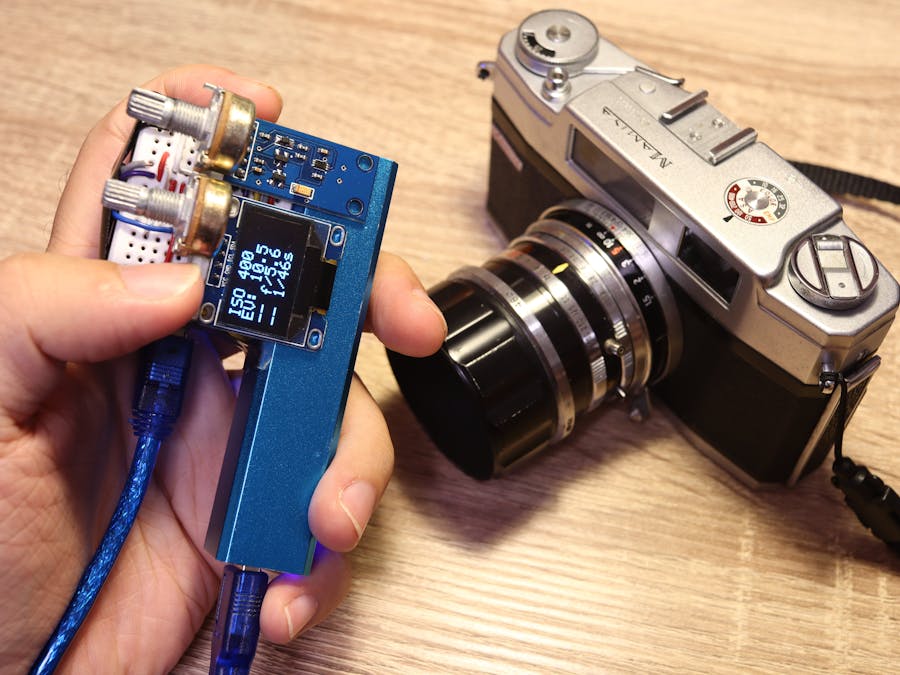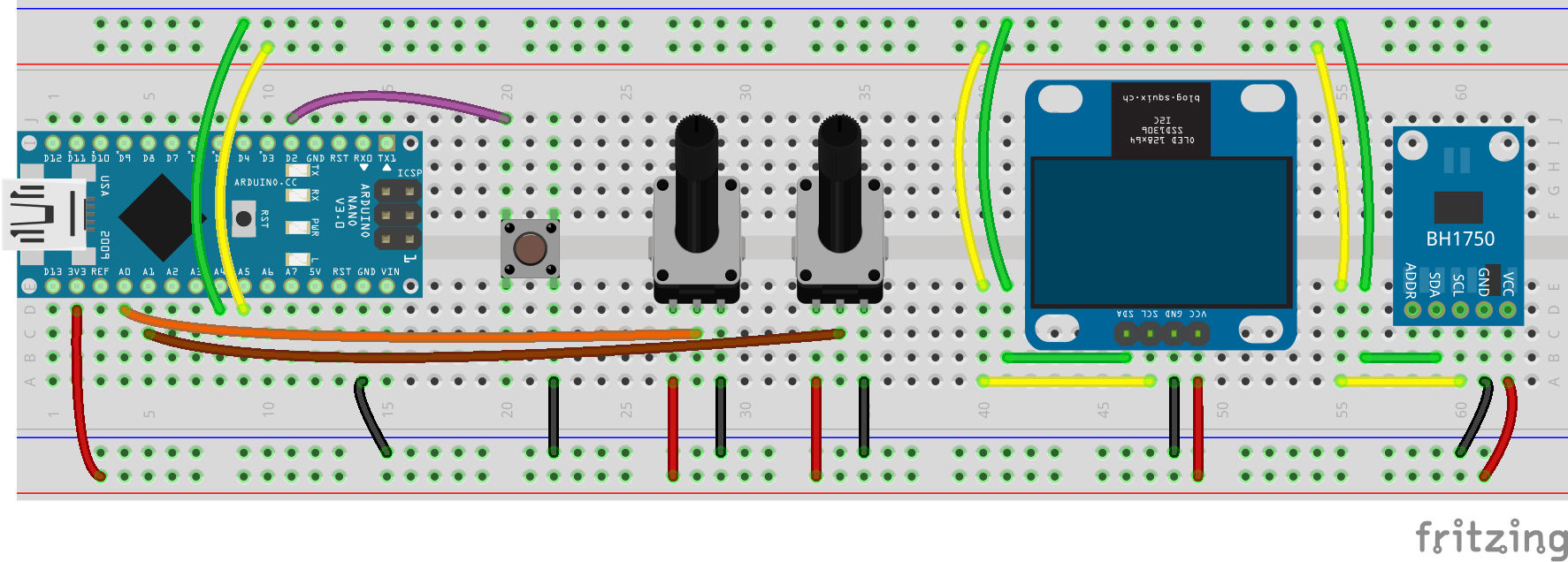/*
ArduMeter (Arduino incident light meter) version 2
by Alan Wang
BH1750/BH1750FVI digital light intensity sensor:
Library: https://github.com/claws/BH1750
VCC -> 3.3V
GND -> GND
SDA -> pin A4
SCL -> pin A5
ADD -> (none)
0.96" SSD1306 OLED 128x64 display:
Library: https://github.com/greiman/SSD1306Ascii
VCC -> 3.3V
GND -> GND
SDA -> pin A4
SCL -> pin A5
1x push button
leg 1 -> pin D2
leg 2 -> GND
2x 10 kOhms potentiometer (knob)
leg 1 -> 3.3V
leg 2 (middle) -> pin A0/A1 (max analog signal about 730-740)
leg 3 -> GND
------------------------------ */
// Set this to true if you wish to get "standard" shutter settings
#define STANRARD_SHUTTER_SPEED false
// Calibration constant (C) for incident light meters.
// see https://en.wikipedia.org/wiki/Light_meter#Calibration_constants
#define INCIDENT_CALIBRATION 330
// Max analog readings from potentiometers. Change it only if you are
// using different input voltage or potentiometers that are not 10K.
#define KNOB_MAX_ANALOG_READING 740
// Define pins
#define BUTTON_PIN 2 // D2
#define KNOB_APERTURE_PIN 0 // A0
#define KNOB_ISO_PIN 1 // A1
// Pre-defined aperture and ISO settings. Modify them for your own preference.
// Elements in the array have to be sorted from min to max.
const double APERATURE_TABLE[] = {1.0, 1.4, 1.8, 2.0, 2.8, 3.5, 4.0, 4.5, 5.6, 6.3, 8.0, 11.0, 12.7, 16.0, 22.0, 32.0};
const int ISO_TABLE[] = {6, 12, 25, 50, 100, 160, 200, 400, 800, 1600, 3200};
// The "shutterspeed table" array is used when STANRARD_SHUTTER_SPEED is set to true.
// 1/2 (0.5) seconds is expressed as 2, and 2 seconds is expressed as -2.
double SHUTTERSPEED_TABLE[] = {-60, -30, -15, -8, -4, -2, -1, 2, 4, 8, 15, 30, 60, 125, 250, 500, 1000, 2000, 4000};
// If you are using older cameras which have different shutter speed settings,
// you can switch to the folloing array:
// double SHUTTERSPEED_TABLE[] = {-1, 2, 5, 10, 25, 50, 100, 250, 500, 1000};
/* ------------------------------ */
#include <math.h>
#include <Wire.h>
#include <BH1750.h>
#include "SSD1306Ascii.h"
#include "SSD1306AsciiAvrI2c.h"
BH1750 bh1750;
SSD1306AsciiAvrI2c oled;
bool started = false;
int EV, apertureIndex, apertureIndexOld, isoIndex, isoIndexOld;
long lux;
void setup() {
// initialize serial port
Serial.begin(9600);
Wire.begin();
// prepare the shutterspeed table array if needed
if (STANRARD_SHUTTER_SPEED) {
for (int i = 0; i < (sizeof(SHUTTERSPEED_TABLE) / sizeof(double)); i++) {
if (SHUTTERSPEED_TABLE[i] < 0) {
SHUTTERSPEED_TABLE[i] = 1 / abs(SHUTTERSPEED_TABLE[i]);
}
}
}
// setup button
pinMode(BUTTON_PIN, INPUT_PULLUP);
// set the BH1750 in BH1750_ONE_TIME_HIGH_RES_MODE_2
bh1750.begin(0x21);
// "initialize" BH1750 by using it once
bh1750.readLightLevel();
// initialize OLED
oled.begin(&Adafruit128x64, 0x3c);
oled.setFont(System5x7);
oled.set2X();
Serial.println("ArduMeter (Arduino incident light meter for camera) READY:");
Serial.println("- Press button to measure light.");
Serial.println("- Turn knobs to change aperature/ISO.");
oled.clear();
oled.println("ArduMeter");
oled.println("READY");
oled.println("press");
oled.println("button");
}
void loop() {
//read status from button and potentiometers
getKnobIndex();
if (buttonPressed()) { //measure light
if (!started) started = true;
displayExposureSetting(true);
delay(150);
} else { //change aperture/ISO settings
if ((apertureIndex != apertureIndexOld || isoIndex != isoIndexOld) && started) {
displayExposureSetting(false);
delay(150);
}
}
//record potentiometer previous status
apertureIndexOld = apertureIndex;
isoIndexOld = isoIndex;
delay(50);
}
// read if the button is pressed (pulled low)
bool buttonPressed() {
return !digitalRead(BUTTON_PIN);
}
// map knob analog readings to array indexes
void getKnobIndex() {
apertureIndex = round(map(analogRead(KNOB_APERTURE_PIN), 0, KNOB_MAX_ANALOG_READING, 0, sizeof(APERATURE_TABLE) / sizeof(float)));
isoIndex = round(map(analogRead(KNOB_ISO_PIN), 0, KNOB_MAX_ANALOG_READING, 0, sizeof(ISO_TABLE) / sizeof(int)));
}
// measure/calculate and display exposure settings
void displayExposureSetting(bool measureNewEV) {
double aperature = APERATURE_TABLE[apertureIndex];
int iso = ISO_TABLE[isoIndex];
// measure light level (illuminance) and get a new lux value
if (measureNewEV) {
lux = bh1750.readLightLevel();
Serial.print("Measured illuminance = ");
Serial.print(lux);
Serial.println(" lux");
}
//calculate EV
EV = log10(lux * iso / INCIDENT_CALIBRATION) / log10(2);
if (isfinite(EV)) { //calculate shutter speed if EV is neither NaN nor infinity
// calculate shutter speed
double shutterspeed = (pow(2, EV) / pow(aperature, 2));
// choose standard shutter speed if needed
if (STANRARD_SHUTTER_SPEED) {
for (int i = 0; i < (sizeof(SHUTTERSPEED_TABLE) / sizeof(double)) - 1; i++) {
if (shutterspeed >= SHUTTERSPEED_TABLE[i] && shutterspeed <= SHUTTERSPEED_TABLE[i + 1]) {
if (abs(shutterspeed - SHUTTERSPEED_TABLE[i]) <= abs(shutterspeed) - SHUTTERSPEED_TABLE[i + 1]) {
shutterspeed = SHUTTERSPEED_TABLE[i];
} else {
shutterspeed = SHUTTERSPEED_TABLE[i + 1];
}
break;
}
}
}
// output result to serial port
Serial.print("Exposure settings: EV = ");
Serial.print(EV);
Serial.print(", ISO = ");
Serial.print(iso);
Serial.print(", aperture = f/");
Serial.print(aperature, 1);
Serial.print(", ");
Serial.print("shutter speed = ");
if (shutterspeed > 1) {
Serial.print("1/");
Serial.print(shutterspeed);
} else {
Serial.print((1 / shutterspeed));
}
Serial.println("s");
// output result to OLED
oled.clear();
oled.print("EV: ");
oled.println(EV, 1);
oled.print("ISO ");
oled.println(iso);
oled.print("-- f/");
oled.println(aperature, 1);
oled.print("-- ");
if (shutterspeed > 1) {
oled.print("1/");
oled.print(shutterspeed, 0);
} else {
oled.print((1 / shutterspeed), 0);
}
oled.println("s");
} else {
Serial.println("Exposure out of bounds");
oled.clear();
oled.println("Exposure");
oled.println("value");
oled.println("out of");
oled.println("bounds");
}
}















_3u05Tpwasz.png?auto=compress%2Cformat&w=40&h=40&fit=fillmax&bg=fff&dpr=2)
Comments